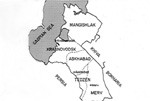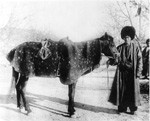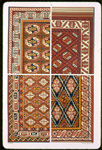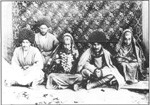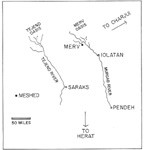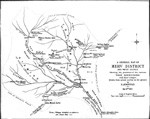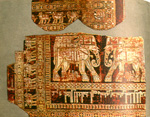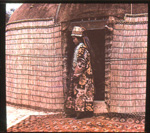 |
|
|
|||||||||||||||||||||||||||||||||||||||||||||||||||||||||||||||||||||||||||||||||||||||||||||||||||||||||||||||||||||||||||||||||||||||||||||||||||||||||||||||||||||||||||||||||||||||||||||||||||||||||||||||||||||||||||||||||||||||||||||||
|
The final phase of Russian expansion into Central Asia began with the decisive defeat of Tekkes at the Geok Tepe stronghold in 1881, made possible in large part by a military railroad soon extended toward Merv, then hooked north to Bukhara, the station opening in 1888.� Military operations were directed from Caucasia (also source of some of the troops) and thus it wasn�t odd for a visitor to see �Turcoman carpets from Merve� in a Daghestan chief�s home.� [1] The rail link gave the previously remote area access to the European market and a major increase in rug exports followed.� This part of Transcaspia province (oblast�), (formed in 1890 after separation from the Caucasian military district) stretches from Kizil Arvat on the west to Merv in the east.� Numerous Turkmen groups long have lived here in oasis settlements based on the seasonal flow of rivers coming down from the mountains and ultimately disappearing into an arid steppe (Kara Qum). �Rulers varied over time among Khiva, Bukhara, and Persia.� Control was frequently quite nominal until the Russians arrived.� The carpet-making activity reviewed in these notes has to do with Ashkabad, Tejend, and Merv � three of the province�s five districts (uezd). Dominant confederations were in each, but all were home to a number of others. � This table presents a fragmentary overview of some products from the three districts in 1900.[2] Economic reports were compiled at the district level; definition of items was not standard, and some years have no data.
There are also some statistics on total province activity, that is, all five districts.� Although depressed by a cholera epidemic that year, in 1892: 2200 -- 3300 carpets and carpet-like items, plus 45,000 �55,000 felts; in 1908: 1750 rugs, 1240 palasi, 738 prayer rugs, 1739 khorjin, 960 small bags.[3] Felt was a far bigger enterprise than carpet and carpet-like items, both in numbers and in value.� Felt production had declined in the late 1880�s, particularly in Ashkabad.[4] Not collected, felts are ignored here; some had esthetic merit, for example, horse furniture: ��the top covering which covers even the neck of the horse and hangs low is ordinarily of felt of a dark color or black, with designs.� [5] And, there is a Turkmen proverb to the effect that �the more beautiful the felt, the more beautiful the woman.� Also, vice-versa. Publications of the Turkmen oeuvre [6] are many, and those of latter days contain very useful work grouping items by details of construction and appearance -- the c. 1930�s Moshkova articles, [7] the Tzareva book a generation later, [8] and particularly, recent essays in magazines and exhibition catalogues.� The standard exposition links rug groups to a Turkmen confederation, and to time and place.� Since motifs are entirely portable and Turkmen weaving uses a limited number of materials and techniques (for example, wefts, two shots and two ply standard but not universal, and color variation among brown, grey, ivory, red) physical sameness does not equal exclusivity, caution is the watch word in assigning rugs to groups and places absent documentation of a connection. The descriptive material which follows is based on government reports and travel accounts, as well as Imperial period publications of Dudin, Felkersham, Semenov (but not Burdukov or Bogolubov) -- all with early 20th century field experience, and Turkmen writings in the 1920�s.� The research notes here are not by any means the full story and are secondary, one among many aspects.� While glimpses of time and place are spotty and merely leitmotif, they do serve to make some assertions in the current rug literature more, and others less, likely���� The text will move from west to east through the administrative districts of Ashkabad, Tejend, and Merv, home to the Tekke, Saryk, Salor, and less well known (Ata, Sunlai, Analu, Murcha, etc.) confederations.� Although an area sketch map or two will appear, a much superior one can be found in the rug literature.[9] Since structural typologies are well rehearsed in rug books, particulars about rugs will only appear as observations of meaningful details by individuals in the area in the period. Some parameters determining the southern rim�s carpet culture are: population -- A census of 1886 compiled by provincial authority [10] and the great Imperial census of 1897 [11] have the numbers which bracket the first phase of a significant growth in carpet-making. �The 1886 count put total population for the three southern rim districts at 247,000 and the number of kibitkas at 45,000; this term means household, estimated 5.5 individuals each, and was used for Russian taxation purposes, and the data may be reasonably accurate.� In 1897 total population was 383,000. Profession statistics were included; 3570 identified as professional carpet makers (the great bulk in Merv),� weavers overwhelmingly female.� Travel accounts give population statistics but accuracy is a question.� A survey of seven of these by Venioukoff led to a composite list: total, 300,000 -- 28,000 Goklen; 60,000 Tekke; 10,000 Saryk; 6,000 Salor; 66,000 Ersari;� Yomuds and various small confederations made up the rest.[12] While there is likely to be a margin of error in any compilations the central point is clear: Turkmen numbers were small, as was also later the case in the 1926 � 1927 census, 719,792 Turkmens in the newly created (November 1924) Turkmen SSR.[13] The republic was an expansion of the province�s territory, via incorporation of the Khiva and Bukhara khanates.� In brief, there were not very many Turkmens. identities -- The political and social structure of 20th c. Central Asia is to a considerable degree a Soviet invention.� �Before the October 1917 revolution, with some very rare exceptions, the idea of belonging to a particular nation, to an Uzbek, Turkmen, or even Tatar nation, simply did not exist in the consciousness either of the Muslim intelligentsia or the public.� [14] The new order has defined Turkmen carpet taxonomy. movement -- Early 19th century travel literature notes the presence of parts of various confederations in places where they were not in later days. �From time to time these groups fought one another causing displacements; struggle would be over oases. Settlements typically had dams and irrigation canals.� conflict -- �Soviet literature (Moshkova, [15] Tzareva [16]) talks about dead gols, a clan�s loss of its traditional principal gol� by being conquered and consequent gol� downgrading to minor articles only.� This claim is doubtful: it is not accompanied by evidence and, more important, seemingly contradicts the record: �While some small groups of Turkmen were probably absorbed by larger groups during these movements, there is no evidence for the occurrence of large-scale absorption of one Turkmen tribe by another.� Instead, the sources indicate that smaller tribes generally fled to other areas rather than try to remain alongside more powerful tribes.� Indeed, there is no evidence for the total disappearance of any Turkmen tribe known to us since at least the seventeenth century.� [17] marriage -- There was a Turkmen reluctance (cultural -- preference for relatives and certain groups; economic -- bride price) to marry outside of the group.� Some information about this is available for Ashkabad, percentage of� registered marriages between different groups: 1920 -- 21%, 1930 -- 16%, 1940 -- 31%.[18] Numbers of those involved are quite low and may have had to do with townies.� This small fact, however, does serve as a reminder that intermarriage could be a minor factor in design migration. � commerce -- Turkmen carpets always had a commercial aspect, steppe nomads bartering (livestock, textiles, etc.) for necessities (metal, etc.). The railroad greatly helped internal trade by being far faster and far more safe than caravan (vulnerable to robbery) and, of course, created an international export market. After the Bukhara khanate became a part of Russia in 1864 one of the standard field teams sent out to inventory new colonies visited Tashkent in the 1870�s -- �two engineers, an hydrographer, two botanists, a geologist, a zoologist, an art historian, and two painters.[19] �S. M. Dudin likely was not present, but was an artist in later surveys.� Drawings were made of some southern rim rugs; one was � Both imperial and soviet empires had economic development programs designed to support local craftpersons working at home (kustary).� Although a Transcaspia kustar� committee was not formed until 1914, well before then there was an established program; results appeared in serial annual output reports from 1880 to 1914 (these are scattered in U.S. libraries and hard to locate). While part of an economic program, this source is a reliable indicator of one set of carpet-makers, indicating what, where, and when.� Piece part counts are fairly low; home use items were almost never included In 1907 the government began to furnish materials. �Its view was that Turkmens in the absence of good customers had to deal with �clever and adroit buyers� and therefore regarded rug making as �woman�s idle work� making �decorations for the home.� �Households went to the marketplace only when forced to by economic circumstance. (A report primarily for higher ups, patronizing and not correct; by this date there was substantial business activity.)� The program featured loans, the provision of vegetable dyes and �best quality wools� from warehouses in Ashkabad and Merv. The utilization of the one in Ashkabad was �somewhat lighter� (by implication, than that of Merv).� Activities also entailed getting rugs into expositions (local, regional, national, and international); thought was given to establishing training schools, as well as workshops for dyeing and weaving; apparently nothing came of it.[20] quality -- Decline began soon after market expansion -- poor synthetic dyes, lower quality yarns, lack of workmanship -- �all due to commercialism.� At the end of the 19th century normal Turkmen practice involved use of imported dyestuffs from Persia and Khiva; [21] in consequence, the Russian imposition of a high tariff in 1890 on Persian goods [22] had the unintended effect of accelerating the adoption of synthetic dyestuffs. Its close companion was a scarcity of good quality therefore older rugs.� Beginning in the last decade of the 19th c. the travel accounts regularly lament this disappearance; typical would be �old specimens are now almost unprocurable and fetch huge prices, but the examples which may still be had are eagerly bought up.� [23] This problem was also noted by kustar� program personnel and by the Imperial and Turkmen carpet authors. Onset generally pegged at 1900; Turkmens (such as one writing in 1926) would mark the beginning as �1.5 or one decade� ago.[24] �Semenov c. 1910 (in Dudin�s view the most knowledgeable author) remarked that natural dyes were the norm �until fifteen or ten years before� and summed rug woes with the usual litany of fading, running, �withering�,�not particularly good weaving and crude coloration�, such rugs being prepared �exclusively for the European trade�.[25]� At the same time I. I. Geier�s similar view was that high demand had lowered quality in the pursuit of �big money�, put the blame on aniline dyes, and recommended the creation of training studios for young women in order to improve quality.[26] Judgments were harsher somewhat later: ��the lowering of artistic quality. Old designs are being forgotten, and kustary use now not only designs that are far more simple, but, even worse, designs that they copy from factory-made rugs.� [27] The Soviets continued kustary support.� There had been�great decay� in carpet-making during the war years (WWI and ensuing civil war), �but in the next two years started to reestablish itself rapidly, particularly in the last year.�� The total of kustary carpet makers was 10,695 -- 70% in hamlets, 30% in urban settings, 70% female.� Some additional numbers were for artels -- in 1926, 20; in 1927, 69; individuals participating in cooperatives in 1926, 463, 4.3% of the total; in 1927, 4,872, 46% the total.[28] Artel could mean either cooperative marketing or a common work site, probably initially the former, then trending to the latter.. �Carpet export statistics also reflect this growth ; in thousands of sq. meters, 1926 � 1.5; 1927 � 6.0; 1928 � 17.0.[29] ASHKABAD DISTRICT [30] The Akhal (white spring) oasis was the district�s heart. The area was agricultural -- truck gardens of melons, cucumbers, pumpkins, cereals, sorghum, some silk -- and also the site of carpet and palas production, the western anchor of a weaving belt which stretched eastward from the village of Kelyat with increasing density to Merv. [31] Principal settlements were Ashkabad town, the district hub, and Kizil Arvat (beautiful maiden). Ashkabad at the end of the 19th century was Tekke, the end result of a long process.� Until the 18th century there were seven major and five subordinate Turkmen groups living as mixed populations in at least six villages and eight hamlets, with additional smaller mixed settlements in outlying areas. Tekke penetration beginning in the 18th century led to the departure of Emreli, Ali-ili, and Karadashli groups for Khiva, although vestiges remained.� The two Tekke wings, Tokhamysh and Utamysh, were divided into numerous large and small associations.[32] Felkersham tells about an individual who when at Geok Tepe in 1878 purchased a palas from a Salor khan, horsemen arrayed on a blue-black ground purportedly returning from a raid.[33] (Similar compositions are on Caucasia�s shadda.) The Tekkes of Akhal were able weavers, using recognizable designs which some travellers of the late 1880�s could distinguish from those of Merv. �At this time Akhal carpets were complimented for fineness and durability, along with high quality felt saddle-covers made as dowry items, and excellent embroideries (burundjuks).[34] Only red and yellow dyes were made locally.[35] A day after the storming of Geok Tepe in 1881 a trader, Gurovitch, �assisted in the pillage� and bought �a large number of valuable carpets� from the soldiers, which were then confiscated by military authorities. The 28 sketches in Astaf�ev's 1885 portfolio of �Akhal Tekke� carpet designs, which initiated their popularity in European Russia, was thought by Semenov to have been made �with utmost accuracy�, but since some carpets possibly were present as booty, a few motifs might not be Tekke. [36] It is nonetheless quite appropriate to view the book as Akhal designs. In 1888 the district population was 47,000 (of which new arrivals were 3,000), primarily Tekke.� In 1897 the total was 92,000, with 19,000 in Ashkabad town and 4,000 in Kizil Ayak.� A key 1897 number is that of professional carpet-makers -- 376.
In 1900 the district was engaged in making household products with some selling in local bazaars but no buyers roaming the hinterland.[38] (Odd, given the year�s production number.)� A traveller in 1901 characterized rugs seen in Ashkabad as �reddish brown, warm, habitually patterned in black or in cream.� Dudin (1926) also there in 1901 used the phrase �brown-carmine color (madder)� and said that Akhal-Tekke rugs, unlike those of the Salors, had a �light-colored reverse� due to the use of undyed white warps, and that the pattern had a �slightly loud effect�.[39] During the first decade of the 20th century there was some thought that Akhal designs to a considerable degree had been adopted by the Tekkes of Merv. � In 1914, in Ashkabad (and in Merv) weavers had been hired �not long ago� in the making of rugs for sale. �At this time the Akhal Tekke were making only red and yellow dyes, the remaining colors were obtained via �yarn from the city.� [40] The first government sponsored carpet exhibition took place at the end of December, 1911.� One hundred items were present, including a few Yomud pieces and eight from Merv and Tejend.� A newspaper account of the event mentioned that Russian settlers were beginning to take up carpet-making, that there should be a school for weavers, and that in new pieces it was difficult to see the outlines around motifs, making the pattern �somewhat hazy�.[41] A descriptive detail appearing in a 1930 export list of Turkmen carpets used the phrase �Akhal-Tekke and Merv (double-wefted) and properly Tekke,� [42] implying that Akhal rugs were not double-wefted.� The Moshkova text of the same vintage made the same point directly.� This assertion caused a reaction .� O�Bannon called it �a glaring error� [43] �since he checked and found no single wefts in a set of published rugs. ��Well, not quite so glaring.� The sample (216) was not large; the 57 single wefted items were all smalls; the double-wefted set contained a mix of carpets and smalls. Bags and the like are irrelevant since Moshkova used the word, �rug�. And it is no good to speculate that Moshkova had current production in mind, in view of her comment that in knot count per inch there was �no essential difference� between older and more recent pieces.� The sample simply can not be used and even if the rug number were given would not be robust enough, as statisticians phrase such matters. If there is a paucity of single-wefted rugs it would be better to think along the lines of the modest Akhal output and the one ten times greater in Merv.� There are indeed single-wefted Tekke carpets; easy access to one is in the Soviet literature.[44] �� An Akhal carpet, wefting unknown, appeared in a 1902 photograph. Semenov praised Akhal for �marvelous palasi� and carpets for �beautiful workmanship, great velvetiness, thinness� and an abundance of white coloration in ornamentation which made them easily distinguished.[45] Dudin had the same view of the rugs, remarking on a generous use of white, distinguishing them from Salor rugs, and recognizable from a distance. [46] TEJEND DISTRICT � Tejend was small in both area and population, wedged between Ashkabad and Merv, and with a much smaller flock.� The 1888 district population was 33,000, 1,000 of whom were new arrivals; 12,000 Tekkes, in a settlement named Kaakh, and 21,000 Salor in and around the border town of Seraks.� The total in 1897 was 49,000 -- 1,500 in Seraks �(in 1927, 559), 400 on the lower Tejend river, and 700 in Kaakh (in 1927, 1400).�� Survey by profession is absent.� Seraks population change is perhaps best explained by migration -- �after the departure of the Salor clan to Persia.� [47] Seraks town, thriving in 1820, Turkmen occupancy since 1795, [48] had been celebrated for the excellence of its carpets prior to its sacking in 1832. In the 1830's Salors living in "Seres" made a palas (called berdtani), which was, puzzlingly, �completely equipped with fringes� and embroidered with silk.[49] In the late 1880�s the people of Seraks did not make carpets and ��their palasi and felts are of very poor quality, serving domestic needs only.� [50] In 1893 some 2000 were in Serakhs.[51] Lessar (mid- 80�s) had put the number of kibitkas in Seraks at 3000; Salors thought four thousand.[52]
MERV DISTRICT Merv is to some extent an occasionally tangled tale of three settlements -- Merv , Yolatan, and Pendeh -- and of three clans: Tekke, Saryk, and, much less so, Salor.� Its central geographic feature is an oasis on the Murgab river.� District population of 1888 was 167,000 (3,000 newly arrived): 110,000 Tekke, 32,000 Saryk in Yolatan town, another 25,000 Saryk in Pendeh.� This survey does not contain occupational information.� In 1897 the population was 119,000, with 8,500 in Merv town.� A key occupational entry in the 1897 census is that of 3194 professional carpet makers. Carpet-making "was widespread" in Merv district in the 1880's. Dyestuffs were imported from Khiva and Persia, only yellow was prepared locally.[54] The kustar’ output is shown below: [55]
In 1898 three-fourths of Transcaspia province's carpets originated in Merv, and Persians were introducing aniline dyes.� [56] Noted again in 1902 as the principal production center, the use of non-fast dyes was continuing.[57] In 1910 Merv was viewed as the center of Turkmen carpet production;[58] immediately prior to World War I it was still considered dominant. [59]� In monetary terms output was equal to that of the four other Transcaspia districts combined. That the largest production came from Merv district stems from �herds greater than that of other districts.[60] A general but apparently quite well-informed travelogue at the beginning of the 20th century contains an overview of the southern rim situation, thus: �the so-called Salor rose was used chiefly in the Merv district; the carpet quality scale in descending order was Pendeh Saryk, Tejend and Ashkabad; old Tekke carpets brought the highest prices and are searched for by pickers, particularly in Merv; in �more recent times� quality had gone down due to use of non-fast dyes and manufacture �in haste for sale�.[61]� Also at this time there was a "great extension" in the Merv oasis of cotton growing, which expanded to 50% of the arable land.� Some Turkmens prospered, but most became impoverished.[62] One interesting wrinkle occurred during the growth of the Merv carpet business. In 1884 there was �the first attempt to imitate Persian carpets, with spectacular results�in 1885 several dozen carpets with Persian designs were sold�; production continued, but declined substantially in 1888. �The same report criticized indigenous designs as �leaving something to be desired in diversity�.[63] Merv town The settlement is located not far from the ruins of old Mari. �A pre-Turk textile which can be dated to about 958 [64] was made there and is illustrated below together with a Prokudi-Gorky photo c. 1914 taken in Turkmen Merv.� In the modern era Merv was controlled at various times by Khiva, Bukhara, Persia, and finally Russia.� The Murgab dam was broken by the Bukhara Emir in the 1780�s.� Saryks had settled in 1794 but had been chased out by Tekke in 1834.[65] In 1888 crowds at Merv's large bazaar numbered in the thousands; exchanged were rugs, saddle covers, bridles, clothing, and linen. (Travel accounts in the Royal Geographic Journal contain similar descriptions.)� Local khans and wealthy individuals were the purchasers; some rugs hung on adobe house walls.� Trade was not a one-way street; �Armenian imported goods shops were present.[66] Merv town was host to government sponsored exhibitions in 1908, 1909 and 1910 (the largest) which were both competitions and sales outlets (1910 gross, 318,460 rubles).� The 1908 affair had 80 rugs and bags, prize winners were photographed, rugs of �beautiful Pendeh design� were present as were iolani (tent bands). �A rug requiring six months of work under a master weaver�s supervision, with �a marvelously nice orange color� in the field was nevertheless rejected because of synthetic dyes in the borders.[67] Eight prizes were awarded in 1910, first to a recently made rug 7 x 5 arshins (16� x 12�) Rugs with aniline dyes were disqualified.[68] After noting that �recently� Merv weavers had �a great enthusiasm� for Akhal Tekke design, Semenov (1911) observed that in these expositions current work with �typical Merv ornamentation was almost absent� and that the �overwhelming majority� imitated �the design of carpets of the Akhal-Tekke and Tejend oases.� [69] Pendeh and vicinity � The intrepid Annette Meakin, illegally in Pendeh in 1896 and again in 1898, got herself photographed.� Lacking a proper town, Pendeh was a large area containing many Saryk villages, a population of 2,500 and a flock of on the order of 300,000.� There was a large weekly bazaar (4,000 in attendance), plus a substantial raw wool export business; carpet-making in part used hired labor.� A weaver's day consisted of 8 to 10 hours and 5 or 6 months were required for a rug 3 by 4 meters in size.� Helpers were hired and paid �an infamous wage�. Rug quality was high.[70] Dudin (1917) in a summary list of rug-making confederations mentioned Salors as being in Pendeh.[71] In the 1880�s according to kustar� reporting Pendeh produced �only felts... the exclusive province of the poorest inhabitants� 5,000 annually; although carpets and palasi were produced, they were mostly for domestic use, and sold locally at very high prices.� [72]� Lessar, contemporaneously, considered that among Saryk exports �first place among them is taken by rugs� and that rug patterns were slightly different from those of Merv, somewhat worse in quality due to use of cotton and absence of silk. �[73] In 1900, Pendeh carpets were the most valued and the most expensive.[74] Another view at this time perceived the descending quality order to be Pendeh Saryk, Merv, Tejend, Ashkabad .[75]� This opinion had staying power.� In 1926 the quality index was "... the best are considered to be the work of the Saryk tribe of the Pendeh oasis, but for the next the work of the Tekkes of Akhal and Merv oases; third place is...." [76] Felkersham, whose work is heavily dependent on other authors and is largely a secondary source, using Dudin as a source, wrote that the Saryks lived in comfortable circumstances, their homes decorated with �extremely valuable carpets� and that they were the �richest Turkmen tribe�. �His view was that a distinguishing characteristic of Salor carpets was the use of cotton in the pattern, this because of lack of mulberry trees in Pendeh,.� [77] Semenov held that the �Turkmen-Saryks of Pendeh� made �the best carpets in all Central Asia� mentioning �magnificent craft, silky pile and with large tasteful areas enclosed with silk�, but that development of cotton culture had killed carpet-making in Pendeh, especially items for sale.[78] Dudin (1926) repeated Semenov�s view that Saryks and Salors �join together� in Pendeh carpet making but had noticed during a visit in 1901 that �Saryks at this time were not engaged in carpet-making.� [79] He had previously written (1917) that the best of the excellent Turkmen rugs were �in all fairness �Salor Pendeh� but that Salor weavers there �a few tens of years ago no longer produce any carpets.� [80] As late as the 1930 Pendeh remained a market label �both on the home market and the foreign market�, and the rugs allegedly were advertised in America as �Black Bokharas� �due to the characteristic background (dark red with strong shading of brown), with a tightness of weave exceeding that of Tekkes."[81] Yolatan Saryk women in Yolatan made �about 25,000 plain and fancy felts annually�.using from 18 to 20,000 puds (abot 300 tons, rather a lot) of wool, primarily from Pendeh; a group made �a thousand or more felts annually for the wholesale trade in Merv�and hire dozens of female workers. �Felt production in 1889, however, �almost ceased�. [82] Lessar discussed Saryk weaving of Iolatan, and mentioned, in spite of Saryk poverty and �poor development ...and difficult connections with bordering countries..[which] explains the insignificant volume of their trade� that there nevertheless was �a considerable trade in felts and in carpets. The carpets differed slightly in design from those of Merv and were slightly inferior in quality, partly due to the presence of cotton and the absence of silk, caused by the absence of mulberry trees.[83] Because of danger of robbers caravans from Yolatan tended to go south to Herat. THE SALORS Ashkabad, Tejend, and Merv are primarily Tekke country but here one encounters the Salors, scattered but concentrated in the vicinity of Seraks.� In the deep past they were one of the two huge Turkmen confederations, Chodors the other. The Soviet rug literature holds that in the 1830�s �a series of tragic misfortunes that almost wiped them out� and as for the rugs, �many have survived�.[84] Dudin (1926) had pointed out that due to the veneration of this confederation and the quality of its carpets some were preserved and entered the marketplace;[85] an assertion, however, that many survivors were still around in the later 20th century needs evidence, evidence which is absent.� Subsequent rug writings have enshrined this view of Salor weaving�s disappearance long ago.� Circumstance undermines this idea; not only did groups continue, in Persian as well as Russian territory, but also there is an explicit hint or two to the contrary; as late as 1910 an observer remarked that the Salor Turkmens had "almost ceased" rug production.[86] The Salor were forced to move by both Yomuds and Tekkes and pushed out of the larger oases by Tekkes and Saryks but were not swallowed up.� Travellers note presence in Tejend: in the 1820�s in Seraks [87] ; discrete groups of Tekkes and Salors in the 1830's; [88] 2000 Salor families in Seraks as of 1832.[89] Before 1850, the Salor had alternated between submission and armed rebellion against the Khiva Khan.[90] They are in a report of 1879 mentioning that some were on the lower Murgab near Persia and Afghanistan.[91]� Lessar somewhat later noted a thousand kibitka along the Murgab interspersed with the �people of Merv� and the Saryks.[92] Salors were then being referred to as the "southernmost Turkmens", on the Murgab; [93] a cohesive group was in neighboring Afghanistan, and on the Murgab in 1885. [94] While Salors had been militarily significant in 1851, [95] �in the late 19th century seemed to consist of scattered groups primarily in Seraks vicinity.[96] As well as those there (about 3,000 families) they were also in Merv (about 700 families) generally poor and weak, leading an agricultural existence. [97] A small contingent also was living in poverty in Merv at this time. [98] Dudin may have got it right in re Salor rugs: �those carpets, produced by them at the present time [which could mean early 1920�s], depart both in high grade merit and in design from�old Salor work, and they are closer to Akhal carpets�constituting an intermediate group between these and others� it is difficult to decide�where to put them�blended characteristics.�� After departing from �their settled places about 80 years ago for the Persian border �a small group remained �among the Saryks and Akhals ��yielding slightly to the influence of the latter� [i.e. Akhal] and, naturally, given reciprocal influence �understandably� both Salor types were being produced.� Shortly after the exodus the remaining groups, both Salors remaining within Russia and their neighbors, did some borrowing.� During the twenty or thirty years the Salors who remained �continued to repeat the old themes� and �placed on the market �old examples.[99] WHAT DOES IT MEAN? These gleanings from the past -- some, facts and some, local color -- have a limited and uneven usefulness dependent on subject matter and interest.� Free standing, they are not conclusive about anything; they, however, might be food for thought: Error -- ubiquitous in rug prose, any type, any time, any writer.� Mistakes can be minor, say, inconsistent proper name spelling or cross wiring of reference notes; or translations.� A title rendered as �the people of Central Asia� rather than the original�s �peoples� loses something.� Mistakes are not all minor � such as an imperial period observation that tent bands were not made in Merv, or a Felkersham comment that all Turkmen rugs are single-wefted.� Or the garbled economic circumstance of Merv Saryks. Errors of comission have a twin, omission.� How many of the kustar� pieces were sold?� What fraction of marketplace rugs comes from this source?� How much weaving took place in the Murgab Estate, the Czar�s usual 10% ownership cut of the empire�s land? �Not rhetorical questions, these. Time -- when something was observed matters.� Not much is frozen in time; the making of rugs in a given location fluctuates.� Reintroduction of natural dyes in Ashkabad and Merv, 1908 -- 1914, means their presence is not an automatic period indicator.� Photographs, however, do freeze time and document connections. Externalities -- �are conditions which drive rug-making: cholera, border closing, cotton culture, agriculture (usually signaling poverty and weaving absence), wars, regieme change.� The Commisar of Nationalities re-wrote the Central Asian history book and imposed policies which denied history. �Peoples became people. Commerce � and its yang and yin nature.� Peasant income improvement coupled with loss of traditional art and substitution of inferior materials. Numbers -- numbers, numbers, what do they mean?� Total female population limits how many workers are available for the loom.� By all measures -- piece part counts, numbers of professional weavers, product value -- Merv activity was ten times greater than Akhal�s.� Probability matters. Uncertainty -- There are no independent variables; all interact in some way and many in �multiple ways. There is much which is not knowable.� The international bazaar�s overly simplistic type categorizations, surely inaccurate, aren�t so bad. . [1] Abercromby, J. A., A Trip Through the Eastern Caucasus, 1889, p. 95. [2] Obzor Zakaspiiskoi Oblasti� za 1900 gode, 1902, pp. 100 -- 117. Subsequent references will be simply OZO plus year or years. [3] OZO 1892, p. 40; Yampolskii, I. P., Kustarnoye delo, Asiatskaya Rossiya, V II, 1914, p. 397-398,. [4] OZO 1883�1889, p. 107. [5] Aucher-Eloy, Remi, Relations de Voyages en Orient, 1843, p. 351 ff. [6] For a decent bibliography see O�Bannon, George W., Oriental Rugs: A Bibliography, 1994, p. 230 ff.�� [7] Moshkova, V. G., Carpets of the People of Central Asia, ed. and trans. George W. O�Bannon and Ovadan K. Amana-Olsen, 1996, from Moshkova, Kovry Narodov Srednei Azii, 1970.� [8] Tzareva, Elena, Carpets and Rugs from Central Asia, 1980, pp. 11 � 15. [9] Wood, William, Turkmen Ethnohistory, in Vanishing Jewels: Central Asian Tribal Weavings, 1990, p. 29. Compiled by William Wood and George W. O�Bannon. [10] Sbornik geografich, nardograficheskikh� i statisticheskikh materialov� po Azii, � Zakaspiiskoi oblast� po 1886, Vol 29, 1888. [11] Pervaya vse obshshaya perepis� naselenia Rossiiskoi imperii, 1897 g., LXXXII Zakaspiiskaya oblast�, 1899 � 1905. [12] Weil, Capitaine, La Turkomanie et les Tourkmens, Journal des Sciences Militaires, mai�juillet, 1880, p. 40. [13] Turkmenovedenie No 10�11, Oct-Nov 1929. Other 1926�27 population data are from this source. [14] Wixman, Ronald, Recent Assimilation Trends in Soviet Central Asia; Dunn, Ethel and Stephen P., Ethnic Intermarriage as an Indication of Cultural Convergence in Soviet Central Asia, in The Nationality Question in Soviet Central Asia, 1973, p. 74, p. 46, p. 57, ed. Edward Allworth,.� [15] O�Bannon/Amana-Olsen, op. cit., p. 319; Moshkova, V. G., Plemennye �goli� v Turkmenskix kovrax, Sovetskaya Etnografiya, 1946, p. 145 ff. [16] Tzareva, op. cit., p. 17. [17] Wood, William, op. cit., p. 36. [18] Per references in note 12. [19] Simakoff, N. F., L�Art de l�Asie Centrale, Recueil de l�Art Decoratif �, Plate Notes #4 -- #7,1883.� [20] OZO 1911, pp. 207�212. [21] OZO 1890, p. 104; Palen, K. K., Turkestan Report, 1911, p. 404. [22] MacGregor, Chas., "Wanderings in Baluchistan", Central Asian Society Journal, Vol VI, Pts. I & II, 1919, p. 75. [23] Norman, Henry, All the Russians, 1902, p. 273. [24] Tikonovich, Kultura ornamenta Turkmenskogo kovra, Turkmenovedenie 4/5 ,April/May, 1930, p. 24; Tumanovich, O., Turkmenistan i Turkmeny, 1926, p. 67. [25] Semenov, A., Kovry Russkago Turkestana, Etnograficheskoe obozrenie, 1911, No. 1�2, p.160. [26] Geier�, I.I., Turkestan�, 1909, p. 165. [27] Yampolsky, op. cit., p.399. [28] Enbaeva, A. M., Kustarnaya promyshlennost� i promyslovaya kooperatsiya �, 1928, p. 104�5. [29] Adamov, A. K., Sovietskie kovri i ikh export p.18�19. [30] There is a related research note, The Akhal Tekke. [31] Vasil�eva, P.S., Akhal�-Tekinskii oazis�, 1888, p.42-43; Weil, op. cit., p. 9. [32] Orozov, A., Etnograficheskie ocherki khozyaistva Turkmen Akhala v XIX -� nachale XX v, 1985, p. 4 ff. [33] Felkersham, Baron A., Starinnye kovry Srednei Azii, Starye Gody, Oct � Dec., 1914, p. 97. [34] Moser, Henri, A Travers l'Asie Central, Paris, 1885, p. 264, p. 330. [35] Felkersham, op. cit., p. 104. [36]Semenov, op.cit., p.104.� [37] Op.cit., per note 38. [38] OZO 1890, p. 112. [39] Dudin, S. M., Kovrovyye izdelya Srednei Azii, Sbornik Muzeya Antropologii i Etnografii, 1928, p.12. The article was published two years after it was written. [40] Felkersham, op. cit., p. 95 p. 104. [41] Turkestanskie Vedemost�, Kovrovoe proizvodstvo v� Turkestane, No.7, January 1912,� [42] Adamov, op. cit., p. 19. [43] Moskova, O�Bannon/Olsen, op. cit., p. 208, p. 218.� [44] Tzareva, op. cit., p. 67. [45] Semenov, op. cit., p. 143. [46] Dudin 1926, op. cit., p. 123. [47] Tikhonovich, op. cit., p. 25. [48] Yampolsky, op.cit, p. 182. [49] Aucher-Eloy, op. cit., p. 351 ff, [50] OZO � 1884�1889, p. 107. [51] Yate, Lt-Col. C. E., Khorasan and Sistan, 1900, p. 34; O�Donovan, op. cit., p. 173, p. 361.� [52] Lessar, P. M., Yugo-zapadnaya Turkmeniya, 1885, p. 54; [53] OZOs per note 38.� [54] OZO 1890, p. 104 ff. [55] OZOs per note 38. [56] Skrine, F. H., and Ross, E. D., Heart of Asia, London, 1899, p. 323. [57] OZO 1900, p. 55 ff. [58] d'Allemagne, Rene-Henri, Du Khurassan au Pays Backhtiaris, Vol III, 1911, p. 36. [59] Ibid. [60]OZO 1911, p. 211--212. [61] Mamodov, op. cit., pp. 114�116. [62] Shestakov, A. V., "Vostanie v Srednei Azii 1916 g.", Istorik Marksist, No. 2, 1926, p. 106. [63] OZO 1889, p. 113. George O�Bannon may have seen a couple of these. [64] Frye, Richard E., Bukhara, The Medieval Achievement, 1965, p. 61. [65] Weil, op. cit., p. 48. [66] Le Compte de Cholet, Pierre, Excursion in Turkestan, Paris, 1889, p. 67, p. 146. p. 187. [67] Kovrovaya vystavka v� Merve, Turkmenistan Vedemost� Dec. 6�7, 1910; for 1909, Vedemost� 46. 1, Mar. 4, 1909. [68] OZO 1910, p. 104 ff., pp. 112/113. [69] Semenov, op. cit., p. 143--144. [70] de Cholet, op. cit., p. 184--186. [71] Dudin, Kovry Srednei Azii, Stolitsa i Usad�ba, No. 77-78, March 30, 1917, p. 12. [72] OZO 1890, op. cit., pp. 104 � 106.�� [73] Lessar, op. cit., PP. 54 � 56. [74] OZO 1900, pp. 100�117. [75] Dimitriev-Mamonov, op. cit., p. 115. [76] Tumanovich, op, cit., p. 67. [77] Felkersham, op. cit., p. 97.� [78] Semenov, op. cit., p.143--144. [79] Dudin 1926, op. cit., p. 115. [80] Dudin 1917, op. cit., p. 12. [81] Adamov, op. cit., p. 19. [82] OZO 1883�1889, p. 110. [83] Lessar, op. cit., p. 53. [84] Tzareva, op. cit., p. 18. [85] Dudin, 1926, op.cit., p. 115. [86] Yampolskii, op, cit, p. 347. [87] Fraser, James B., Narrative of a Journey Into Khorassan, Appendix B. 1825, p. 41. [88]Relation de l'Ambassade au Kharezm de Riza Quoly Khan, trans. Chas. Schefer, Ecole des langues oriental, Paris, 1st Series, Vol III-IV, 1876, p. 29. [89] Burnes, Alexander, Travels into Bokhara, London, Vol. II, p. 51. Hearsay but its source is good. [90]Riza Quoly Khan, op. cit., p. 109. [91] Weil, Captain, op. cit., p. 37 [92] Lessar, op. cit., p. 54. [93] Spaulding, Capt. Henry, op. cit., p. 53. [94] The Illustrated London News, March 7, 1885, p. 248. [95] Riza Quoly Khan, op. cit., pp. 109 -- 112. [96] Yate, C. E., op. cit., p. 34; O'Donovan, op. cit, Vol II, p. 173, p. 361. [97] Lessar, P. M., Yugo-zapadnaya Turkmeniya, 1885, p. 54. [98] O'Donovan, Edmund, The Merv Oasis, New York, 1885, Vol. II, p. 173, p. 361. [99] Dudin 1926, op. cit., p. 115.
|
|||||||||||||||||||||||||||||||||||||||||||||||||||||||||||||||||||||||||||||||||||||||||||||||||||||||||||||||||||||||||||||||||||||||||||||||||||||||||||||||||||||||||||||||||||||||||||||||||||||||||||||||||||||||||||||||||||||||||||||||
